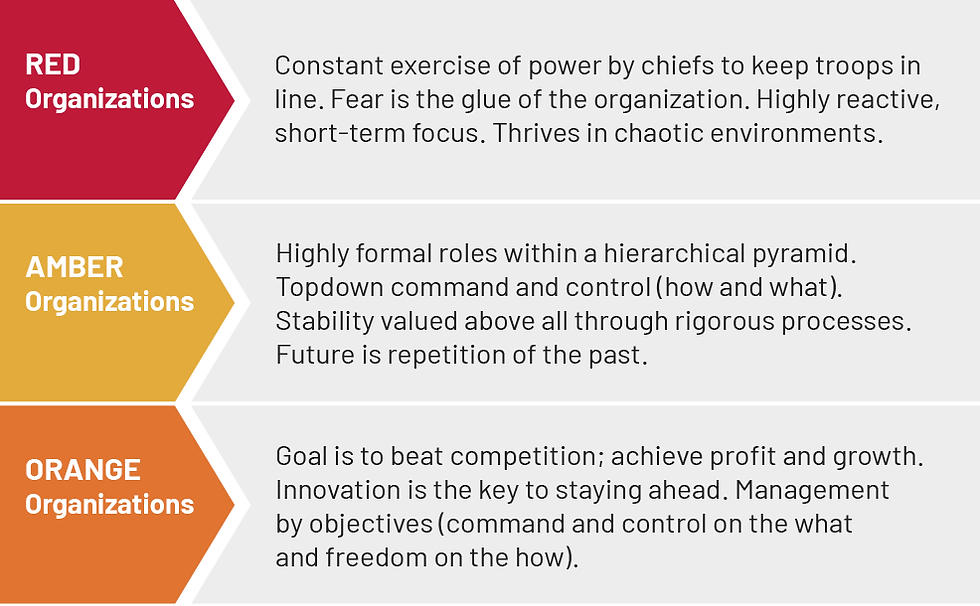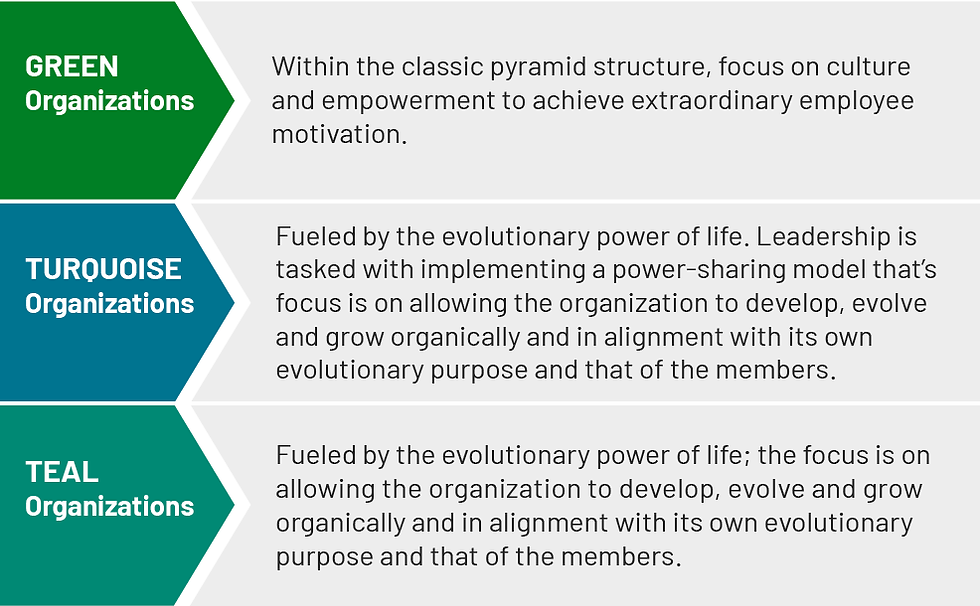It Is Time for a Paradigm Shift
- Dr. Robyn Short

- Feb 11, 2022
- 5 min read
Updated: Mar 6, 2023
Reimagining organizations by devising an innovative model that encourages productive, fulfilled, and engaged employees.

It has been two years since Covid-19 disrupted organizations across the U.S. and around the world. We all wondered how we might use this disruption to learn and grow — individually and collectively. We promised we would emerge anew. And yet, our new norm looks strikingly similar to business as usual.
An organizational paradigm is the overarching approach to conducting business that underlies all theories and methodologies informing the way the organization conducts business, builds culture, and sustains innovation and growth. Prior to the crisis brought on by COVID-19, most organizations in the U.S. operated in the Orange Business Paradigm. The management approach of organizations operating in this paradigm is by objectives. Management dictates the commands and controls with regard to the what but allows for some freedom on the how. “Wisdom and strategy” are mistakenly perceived as “leadership competencies and responsibilities.” Acting on that wisdom is the activity of management and workers. These organizations function, metaphorically, like a machine. I refer to them as Newtonian Organizations because they each embody the traditional leadership style that assumes that force must be applied in order to achieve motion and that the amount of force applied is directly proportional to the amount of movement achieved. Newtonian organizations implement a system of coercion and dominance to achieve growth.

Due to COVID-19 and the economic shutdowns that rippled across the nation and around the world, organizations were forced to pivot quickly and creatively in order to survive. As a result of furloughs and layoffs, organizations relied on fewer people to solve new and complex problems. The ability to think critically and creatively became an expectation of all employees. And, importantly, organizations relied on their employees’ ability to self-manage. In fact, many people found themselves without a leader or manager to whom they directly reported. Workers had to get out of their prescribed roles and pick up new responsibilities. Some organizations began to seek the wisdom that resided in all their employees, not just leadership. In short, some organizations naturally took on the qualities of a Quantum Organization.

Quantum Organizations, specifically those operating in the Turquoise or Teal paradigms, accept that in order to address the challenges that come with an ever-changing and modern world, we must embrace a new way of organizing how we work, how we collaborate, how we relate to and with one another, how we think, how we problem-solve, and how we source our collective knowledge and wisdom. There are three fundamental elements to the Turquoise and Teal paradigms, and the first two of these elements naturally emerged in some organizations as they pivoted to survive the COVID-19 pandemic.
Self-Management: Quantum Organizations operate without hierarchical decision-making. They have found that the key to operating effectively is within a system of peer-based relationships. Members are empowered to self-manage and are given access to the resources and decision-making power necessary to do so.
Wholeness: Quantum Organizations have developed a consistent set of practices that invite every person within the organization to reclaim his or her inner wholeness and to bring all of who they are to the workplace. Quantum Organizations desire and expect that individuals show up fully, wholly, and authentically.
Evolutionary Purpose: Quantum Organizations have a life and a sense of direction of their own. Instead of trying to predict and control the future of the organization, members are all invited to listen in and understand what the organization itself wants to become and what purpose it wants to serve and to explore their role in bringing that purpose forward.
Self-Management. As a result of the reduced staff and reorganization of resources that occurred as a result of Covid-19, many organizations naturally shifted into a self-managed environment. Employees found themselves collaborating to solve problems that did not usually fall within their job description. And the expertise and wisdom they brought to the organization was relied on in new ways. New ways of ideating and innovating naturally occurred. It became obvious that people are able to self-manage and be self-directed and that the organization benefits when they do.
Wholeness. New practices emerged that invited everyone to participate more fully in the livelihood of the organization. One person interviewed for this article shared how his organization initiated a weekly “storytelling” session where people within the sales organization shared the challenges their customers were facing and the solutions they found to address them. Not only did this invite empathy and deepening of understanding about the lived experiences of real people facing real problems, it also invited creativity, collaboration, and an invitation to step out of one’s typical role as the organization sought new ways to serve their clients. New understandings about the wisdom, expertise, and knowledge that resided within the organization emerged. People were invited to bring the fullness of themselves into the workplace in order to best meet the rapidly changing needs of the organization. Reduced “head count” and hiring freezes meant people were called on to solve problems they would ordinarily would not be involved in.
And then just as a new normal was settling in, just as people were experiencing the fullness of who they are in the workplace, just as the organization was enjoying the wisdom and expertise that resides in all of their employees not just some of them, the hierarchy and behaviors of the Orange paradigm began to settle back in. And there is a reason for that.
Every organization is a system. A system is a collection of components that interact together to perform a function. Systems are inherently self-sustaining, self-correcting, and self-perpetuating.
Unless the system experiences an intentional redesign, or re-founding, and measures are put in place to ensure the integrity, characteristics, and functions of the new system are preserved, it will naturally revert to the original operating system. This is what began to occur six months into the pandemic in many businesses across the U.S. The characteristics associated with Quantum Organizations that naturally emerged were pushed out by the old way of doing things. The hierarchy re-asserted itself. The pressure to conform reinstated itself. The wisdom that resides across organizations was once again silenced. People were pushed back into their lanes. The fullness of who people are and the richness of the expertise they bring to their organizations was no longer invited. The promise of a new normal was not realized.
And then something really interesting happened. 38 million people said "no." And they walked out on their jobs.
The Great Resignation presented itself as an opportunity to fully Reimagine the Workplace. Organizations will need to create a major paradigm shift from Newtonian to Quantum to meet the needs of a changed workforce.
By design, Quantum Organizations create peace in the workplace. Peace is human security and the ability to experience a life of dignity.
Organizations that commit to designing, implementing, and sustaining a workplace culture of peace bring to life a healthy functioning system that is able to grow and evolve in accordance with its own evolutionary purpose and that of its members. A workplace system of positive peace creates the optimal environment for human potential to flourish. And when people thrive, organizations thrive.
Dr. Robyn Short is the president and CEO of Workplace Peace Institute – an organizational systems design and research firm that is singularly focused on creating workplace cultures where people thrive. Workplace Peace Institute supports small to mid-sized businesses in optimizing employee engagement, maximizing organizational productivity, and improving profitability by infusing human security and dignity as foundational attributes of their business model.


